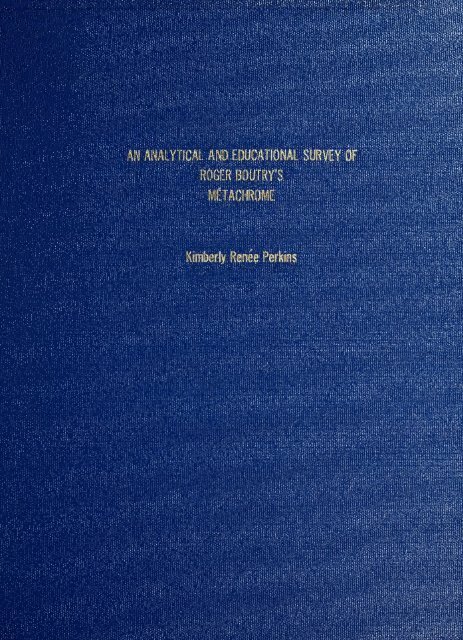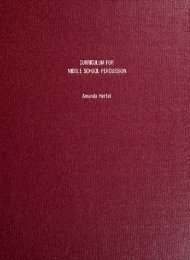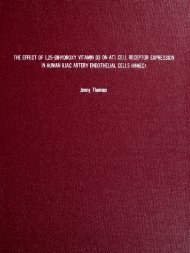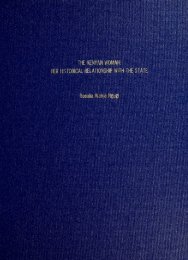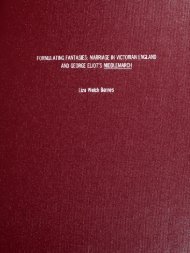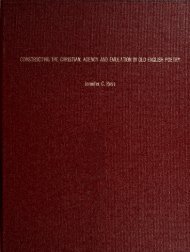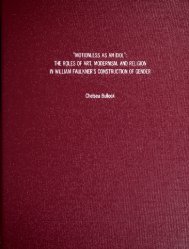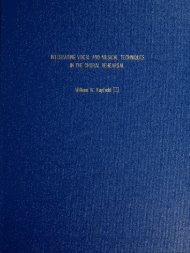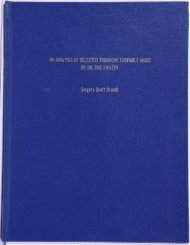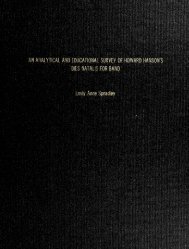An Analytical and Educational Survey of Roger Boutry's Mtachrome
An Analytical and Educational Survey of Roger Boutry's Mtachrome
An Analytical and Educational Survey of Roger Boutry's Mtachrome
You also want an ePaper? Increase the reach of your titles
YUMPU automatically turns print PDFs into web optimized ePapers that Google loves.
Digitized by the Internet Archivein 2012 with funding fromLYRASIS Members <strong>and</strong> Sloan Foundationhttp://archive.org/details/analyticaleducatOOperk
The undersigned, appointed by the Schwob School <strong>of</strong> Music at Columbus State University, haveexamined the Graduate Music Project titledAN ANALYTICAL AND EDUCATIONAL SURVEY OFROGER BOUTRY'SMETACHROMEpresented by Kimberly Renee Perkins,a c<strong>and</strong>idate for the degree <strong>of</strong> Master <strong>of</strong> Music Education<strong>and</strong> hereby certify that, in their opinion, it is worthy <strong>of</strong> acceptance.(Project Advisor)L4y%^I^^
Columbus State UniversityAN ANALYTICAL AND EDUCATIONAL SURVEY OFROGER BOUTRY'SMETACHROMEByKimberly Renee PerkinsA GRADUATE PROJECTSubmitted to the Faculty<strong>of</strong> Columbus State Universityin partial fulfillment <strong>of</strong> the requirementsfor the degree <strong>of</strong> Master <strong>of</strong> Music EducationColumbus, GAApril 2009
TABLE OF CONTENTSChapterPageABSTRACT 1PART I: HISTORY OF MODERN FRENCH MUSIC1 MODERNFRENCH MUSIC 2PART II: ANALYSIS OF ROGER BOUTRY'S METACHROME2 BIOGRAPHICAL INFORMATION 8Biography 8Wind B<strong>and</strong> Compositions 103 SCORE INFORMATION 11Program Notes 11Instrumentation 124 FORM AND MELODY 135 HARMONY 216 RHYTHM 237 ORCHESTRATION AND DYNAMICS 26PART III: TEACHER'S GUIDE8 PERFORMANCE NOTES 289 STANDARDS & SEQUENCE 3310 LESSONS 36
Lesson 1 36Lesson 2 43Lesson 3 48Lesson 4 50Lesson 5 54Lesson 6 57PART IV: STUDENT HANDOUTS11 STUDENT HANDOUTS 59Vocabulary Terms 59Vocabulary Test 63Rondo Assignment 65Powerpoint Assignment 66Composition Assignment 67Performance Evaluation 68REFERENCES 69APPENDIX A: CHARTS OF METACHROME 71APPENDIX B: MUTE CHART 73APPENDIX C: PIANO REDUCTIONS 75Primary Theme 76Melody from Second Movement 77APPENDIX D: CD OF METACHROME, PERFORMED BY THE COLUMBUS STATEUNIVERSITY WIND ENSEMBLECD
ABSTRACTThis project is an analytical <strong>and</strong> educational survey <strong>of</strong> <strong>Roger</strong> <strong>Boutry's</strong> Metachrome, aFrench wind b<strong>and</strong> piece written in 2003. Part I <strong>of</strong> this project explores the history <strong>of</strong> modemFrench music. Part II is an analytical perspective <strong>of</strong> the composition. Part III presents a teachingapproach, including teaching materials such as lesson plans, assignments, <strong>and</strong> rubrics. Part IVincludes student h<strong>and</strong>outs that coincide with the teacher lesson plans. Additional resources forthe conductor can be found in the Appendix section.
PARTIHISTORY OF MODERN FRENCH MUSIC
Chapter 1MODERN FRENCH MUSICBy the twentieth century, music in Europe was going in two directions at once. Musicwas moving forward with prospects <strong>of</strong> new worlds to conquer in realms <strong>of</strong> sound, yetmaintaining the fin-de-siecle (characteristic <strong>of</strong> late nineteenth century sophistication)reminiscence <strong>and</strong> the reluctance to move forward. France remained conservative, but thisresistance to new ideas <strong>and</strong> techniques was gradually overcome during the first sixty years <strong>of</strong> thetwentieth century (Myers, 1971). This overview will show the progression <strong>of</strong> modern Frenchmusic to better underst<strong>and</strong> the French music style in <strong>Roger</strong> <strong>Boutry's</strong> Metachromc.It was at this time that the idea <strong>of</strong> nationality in music surfaced. Nationalism is defined as"music that purposefully expresses 'nationalist' or 'national' characteristics by the deliberatecultivation <strong>of</strong> 'folk' elements or by the dramatization <strong>of</strong> colorful or heroic episodes in acountry's history" (Myers, 1971). The purpose <strong>of</strong> European Nationalism was to break away fromthe supremacy <strong>of</strong> German music <strong>of</strong> the nineteenth century <strong>and</strong> re-establish musical developmentin non-German nations. Smaller countries were the first to emerge, such as Bohemia <strong>and</strong>Hungary. Russia even developed a Nationalist school to counteract what was considered "theharmful influence <strong>of</strong> German music" (Myers, 1971).Nationalism in music can be viewed in different ways. One way is the conscious attitudetowards music, or a way <strong>of</strong> writing music, that is associated with a given nationality. Certaincountries have their own musical styles <strong>and</strong> traditions that are not necessarily influenced by orinclude popular or folk musical elements. Therefore, a piece can be associated as being German,Italian, French, or other nationalities through character, feeling, <strong>and</strong> style, even though it mayreflect nothing but the personality <strong>of</strong> the composer or national characteristics. As a result, a
French nationalism in music is represented by a distinct sound. For example, Frenchcomposers have a tendency to emphasize the upper tessitura in their scoring, where there is lessemphasis in the bass voices.Therefore, the overall balance leans towards the woodwind colors.This is not an intentional decision made by composers, but rather a subliminal tradition that hasbecome a part <strong>of</strong> the French National sound.By the twentieth century French composers were progressing in their development <strong>of</strong>musical prominence in Europe. 1900 was the year <strong>of</strong> the Great Exhibition, which made Paris thecenter <strong>of</strong> attraction in Europe for tourists all over the world. At this time Saint-Saens, Massenet,Faure, <strong>and</strong> d'lndy were still prominent names in French music. According to Myers, GabrielFaure (1845-1924) became known as one <strong>of</strong> the most important ''transitional composers" whowere still the representatives <strong>of</strong> French music at the beginning <strong>of</strong> the twentieth century (1971 ).Faure was known for his advances in melody <strong>and</strong> harmony, was a master <strong>of</strong> creating longmelodic phrases, <strong>and</strong> was using the whole tone scale <strong>and</strong> hinting at Impressionism as early as1877. A brilliant example <strong>of</strong> this longevity is the thirty bar melody from his Requiem, "Inparadisian".Faure also modulated frequently, maintaining a sense <strong>of</strong> tonality by quicklyreturning to the original key, focusing on entire phrases instead <strong>of</strong> individual chords. Heremained the most advanced figure in French music until Debussy's Pelleas et Melis<strong>and</strong>e(Nectoux, 2008).Claude Debussy (1862-1918) was a radical revolutionist, the opposite <strong>of</strong> Faure (Rost<strong>and</strong>,1973). Although many link Debussy with Impressionism, it may be more accurate to tie him withsymbolism. Debussy's music evokes moods, feelings, <strong>and</strong> atmospheres as opposed to expressingdeep emotion or stories, which is especially evident in Prelude a L 'apres-midi d'imfaime.He isparticularly known for his unique harmony <strong>and</strong> colorful orchestrations. Debussy created musical
images through motives, harmony, <strong>and</strong> exotic scales (whole tone, octatonic, <strong>and</strong> pentatonic) <strong>and</strong>did not focus on resolutions. He treated music as an art <strong>of</strong> sound, particularly through timbre <strong>and</strong>would <strong>of</strong>ten associate particular instruments with motives <strong>and</strong> separated musical layers throughtone color.Although large orchestras are required for many <strong>of</strong> his works, Debussy used soundsfor color, not for volume (Grout, 2006).Erik Satie (1866-1925) is known for his innovations in the use <strong>of</strong> parallel ninths, but it ishis "anti-Debussy mentality ,, that is <strong>of</strong> particular interest (Rost<strong>and</strong>, 1973). He was a strongadvocate for "the unembellished <strong>and</strong> the bare, <strong>and</strong> his search for simplicity <strong>and</strong> systematicnakedness" (Rost<strong>and</strong>, 1973). Satie's importance lies in directing the new generation <strong>of</strong> youngFrench composers away from impressionism towards a more concise style, Neo-classicism(Satie, 2008). This led to the group <strong>of</strong> composers known as Les Six, made up <strong>of</strong> composersGeorges Auric, Louis Durey, Arthur Honegger, Darius Milhaud, Francis Poulenc, <strong>and</strong> GennaineTailleferre, <strong>and</strong> the group was given its name in 1920 by the critic Henri Collet. Les Six wereunited by their anti-Romanticism <strong>and</strong> appreciation for Satie's music, but soon broke <strong>of</strong>f intodifferent paths (Griffiths, 2008). Honneger became a serious minded symphonic composer,Milhaud pursued polytonality, Durey became a committed Socialist, <strong>and</strong> Tailleferre faded awayalmost completely. Poulenc <strong>and</strong> Auric were the only two to maintain loyalty to the group'soriginal st<strong>and</strong> that music should be "spare, witty, <strong>and</strong> up to date" (Griffiths, 2008).The 1930s was a stagnant period for France in regards to innovations in music <strong>and</strong> thearts. Composers during this time include Henri Sauguet, Jacques Ibert, Jean Francais, JeanRivier, <strong>and</strong> Maurice Jaubert. This marked the end <strong>of</strong> the predominance <strong>of</strong> melody <strong>and</strong> solidtonality in French music, <strong>and</strong> after WWII French composers began experimenting <strong>and</strong> looking
for new techniques, like the non-French Second Viennese School stemming from Schocnberg'sinfluential 12-note method, developing into total serialism (Collaer, 1961).Olivier Messiaen (1908-1992) could be considered the most important French composerbom in the twentieth century. <strong>An</strong> organist <strong>and</strong> teacher <strong>of</strong> harmony at the Paris Conservatoire, hehas contributed major innovations to musical composition. He is most known for his obsessionwith birdsongs <strong>and</strong> transcribing bird sounds to use in his music. Messiaen also introduced histheory <strong>of</strong> modes <strong>of</strong> limited transposition, where collections <strong>of</strong> notes would remain unalteredwhen transposed by certain intervals, similar to, but not including the whole tone <strong>and</strong> octatonicscales (Grout, 2006). These modes were based on the chromatic scale <strong>and</strong> do not imply aparticular tonality. One particular chord <strong>of</strong> interest is his "chord <strong>of</strong> resonance' 1that contains afundamental note <strong>and</strong> its odd harmonics up to the fifteenth. This use <strong>of</strong> added resonance unitesthe separate concepts <strong>of</strong> harmony <strong>and</strong> timbre into one, allowing harmony to function as timbre<strong>and</strong> for Messiaen's chords to become "sound entities", complete in themselves (Johnson, 1975).Messiaen also used static harmony, where chords simply remain stationary, creating a sense <strong>of</strong>meditation, avoiding moving forward to a resolution. <strong>An</strong>other contribution to compositionalprogress was the approach to rhythm as durations, instead <strong>of</strong> meter. <strong>An</strong> example <strong>of</strong> this is theadded value concept adding small durational values to produce irregular lengths. <strong>An</strong>otherrhythmic technique he used was the nonretrogradeable rhythm (a rhythmic pattern that is thesame when read forwards or backwards, like a pendulum). Messiaen was also known forrecombining timbre groupings to create new sounds, like "colorful shapes in a kaleidoscope"(Grout, 2006). His compositional characteristics are described in his 1944 book, The Technique<strong>of</strong>my Musical Language (Burkholder, 2006).
One <strong>of</strong> Messiaen's greatest students was Pierre Boulez (b. 1925). When Boulez heard 12-tone music for the first time in 1945, he had found "the answer he had been searching for on bothaesthetic <strong>and</strong> psychological grounds" (Peyser, 2008). He experimented with serialism, the newmusique concrete <strong>of</strong> the 1950s, electronic sounds, <strong>and</strong> indeterminacy (Boulez, 2008).In the 1 970s, composers across Europe began to experiment with the acoustic properties<strong>of</strong> sound, developing into what is known as spectral music, or spectralism. Spectral musicemphasizes "the importance <strong>of</strong> sound <strong>of</strong> the sound spectra themselves to the music <strong>and</strong> itstechniques" (<strong>An</strong>derson, 2009). Spectralism has been primarily associated with a group <strong>of</strong>composers <strong>of</strong> the French Groupe de l'ltineraire, mainly Gerard Grisey <strong>and</strong> Tristan Murail(<strong>An</strong>derson, 2009).This brief overview <strong>of</strong> twentieth century French musical composition shows the cohesion<strong>of</strong> musical goals <strong>and</strong> interests among French composers <strong>and</strong> the progression <strong>of</strong> French musicthroughout the period, giving a historical context leading up to <strong>Roger</strong> <strong>Boutry's</strong> Metachrome. It isevident that most <strong>of</strong> the musical innovations <strong>of</strong> France have largely been connected to theexperimentations with new sounds through color <strong>and</strong> orchestration. <strong>Roger</strong> <strong>Boutry's</strong> Metachromeshares in nationalistic taste for colors in music. Perhaps it is the influence <strong>of</strong> the astoundingFrench painters or the love <strong>of</strong> art itself that created this array <strong>of</strong> color that has, with no doubt,deeply impacted the advancements <strong>of</strong> French music in the twentieth century.
PART IIANALYSIS OF ROGER BOUTRY'S METACHROME
Chapter 2BIOGRAPHICAL INFORMATIONBIOGRAPHY<strong>Roger</strong> Boutry (b.1932) was bom in Paris to a musical family. His father was thetrombone soloist <strong>of</strong> the Orchestre National de France as well as the co founder, along with Frenchcomposer, conductor, <strong>and</strong> violist Desire-Emily Inghelbrecht (1880-1965). Boutry studied at theParis Conservatory with master teachers, including Jean Doyen for piano, Tony Aubin forcomposition, Nadia Boulanger for piano accompaniment, Louis Fourestier for conducting, NoelGallon <strong>and</strong> Henri Challan for harmony, fugue, <strong>and</strong> counterpoint, <strong>and</strong> Olivier Messiaen foranalysis (Boutry, 2003). <strong>Boutry's</strong> musical career spans over more than fifty years in Frenchmusic history.Boutry was awarded at least eight first prizes in composition, his most notable awardbeing the 1 954 Premier Gr<strong>and</strong> Prix de Rome. The board <strong>of</strong> examiners for this award includedArthur Honneger, Florent Schmitt, <strong>and</strong> Paul Paray. Some other awards Boutry received were the1986 Medaille de vermeil de la ville de Paris, which awards honorary citizenship in Paris, <strong>and</strong>the promotion to Chevalier de legion d'honor in 1990, one <strong>of</strong> the most prestigious awards inFrance that was created by Napoleon Bonaparte in 1802 for outst<strong>and</strong>ing achievements in militaryor civilian life, such as the arts (Nationmaster, 2003). He was also awarded the Gr<strong>and</strong> Prix de laPromotion Symphonique by the SACEM (Corporation <strong>of</strong> Authors, Composers <strong>and</strong> MusicEditors).In addition he was given the Palmes Academiques, also created by NapoleonBonaparte for scholars, scientists, <strong>and</strong> those in the literary <strong>and</strong> artistic fields, as well as the Croixd'or du Merite et Devouement Francais in 1999, an award developed in 1957 to encourage <strong>and</strong>reward those who contribute to the prestige <strong>of</strong> France, both culturally <strong>and</strong> in the field <strong>of</strong> arts,literature, science, <strong>and</strong> sports. Boutry is also credited with the expansion <strong>of</strong> the wind b<strong>and</strong>
epertoire in France, as well as a series <strong>of</strong> recordings. He has published more than seventy worksunder publishers Robert Martin, Salabert, Billaudot, Combre, Eschig, <strong>and</strong> Leduc (Boutry, 2003).In addition to his compositional skills, Boutry is a talented pianist. When he wasseventeen, Inghelbrecht invited him to play Franck's Variation Symphoniques. After this heappeared as soloist under the direction <strong>of</strong> Georges Pretre, Pierre Monteux, <strong>An</strong>dre Cluytens,Pierre Dervaux, Jean Martinon, <strong>and</strong> Karl Ristenpart. Boutry also recorded the original version <strong>of</strong>Gershwin's Rhapsody in Blue <strong>and</strong>, in 1958, won a prize at the first Tchaikovsky competition(Boutry, 2003).<strong>An</strong> accomplished conductor, Boutry has guest conducted for many Parisian associations,such as Colonne, Lamoureux, Pasdeloup, the Orchestre National de France, Orchestre de laSociete des Concerts du Conservatoire, Orchestre National de Belgique, OrchestrePhilharmonique du Luxembourg, New Japan Orchestra, <strong>and</strong> the Sapporo Symphony Orchestra.From 1973-1977 he became the director <strong>of</strong> the Orchestres de la Garde Republicaine (Boutry,2003).In 1962, Boutry was asked to teach a harmony class at the Conservatoire by the director,Raymond Loucheur.Boutry was an influential teacher for thirty years. Some <strong>of</strong> his studentsinclude Xavier Delette, Naji Hakim, Philippe B<strong>and</strong>eris, Claude Pichaureau, Susanne Yoshida,Chikako Oe <strong>and</strong> the Taiwanese pianist Lo Mei-Yah. These are only a few <strong>of</strong> his students whoattest to <strong>Boutry's</strong> inspirational teaching within the French tradition <strong>of</strong> colorful harmony (Boutry,2003).Composer, performer, conductor, <strong>and</strong> teacher, Boutry has had a major influence oncontemporary French music for half a century.
WIND BAND COMPOSITIONSROGER BOUTRYBatteries de I 'empireBeatriceCMF2000Chants de I 'apocolypseConcerto for TrumpetConcert a tons vents, clairons, trompettes et batterieCri de I 'dme (soprano solo)DivertimentoEclats d 'azur (featuring saxophone quartet)En habit d 'arlequinEvocationsJM.ru YorokobiMarche des princes, clairons, batterieMetachromeMon vieux Henin, et batterie-fanfareOuverture pour batteriefanfareTetradeTromboneraVariations sur un theme imaginaire (piano solo)Wu-ji (piano solo)
Chapter 3SCORE INFORMATIONPROGRAM NOTESComposed in 2003 by <strong>Roger</strong> Boutry, Metachrome is an excellent example <strong>of</strong> the French b<strong>and</strong>aesthetic at the beginning <strong>of</strong> the twenty- first century. The primary melody is used throughout thecomposition in the form <strong>of</strong> melodic <strong>and</strong> motivic variants. The title can be translated as "change<strong>of</strong> colors", represented through the aural shifts in sound from the different groupings <strong>of</strong>instruments developing the themes as well as the contrasting styles portrayed. <strong>Roger</strong> Boutry hasbeen one <strong>of</strong> the leading composers in France for the past fifty years. Pianist, composer, <strong>and</strong>conductor, he studied at the Paris Conservatory <strong>and</strong> was appointed the head <strong>of</strong> the Orchestras dela Garde Republicaine in 1973, where he remained until 1997. Boutry has contributed manypieces to the French repertoire for wind b<strong>and</strong> <strong>and</strong> solo instruments (Boutry, 2003).
INSTRUMENTATIONPiccoloFlutes 1,2OboeBassoonE-flat ClarinetB-flat Clarinets 1 , 2B-flat Bass ClarinetE-flat Alto Saxophones 1, 2B-flat Tenor Saxophones 1 , 2E-flat Baritone SaxophoneF Horns 1, 2, 3, 4/E-flat Horns 1, 2, 3, 4C Trumpets 1, 2, 3/B-flat Trumpets 1, 2, 3C Trombones 1, 2, 3/B-flat Trombones 1, 2, 3C Euphonium/B-flat EuphoniumB-flat Contrabass/E-flat ContrabassCTubaString BassHarpPercussion:Timpani1 - Glockenspiel, xylophone, crotales, antique cymbal2 - snare drum, bass drum, tambourine3 - suspended cymbal, crash cymbal, xylophone, Chinese pads, wood-block,Tam-tam, cowbell, claves4-3 toms, maracas, Chinese blocks
Chapter 4MELODY AND FORMI. <strong>and</strong>ante, allegroThe first movement <strong>of</strong> <strong>Boutry's</strong> Metachrome is in a loose sonata form. The introductionbegins with a descending tritone <strong>and</strong> minor third motive that reoccurs throughout.This opening sounds mysterious, leading into the exposition.The primary theme is an 18 measure phrase that begins as an alto saxophone solo <strong>and</strong> isseamlessly passed on to a clarinet solo <strong>and</strong> is then joined by the flutes.The phrasing is symmetrical (9+9) <strong>and</strong> in both sections the contour generally ascends for fourmeasures <strong>and</strong> descends for five. The primary theme uses all12 notes <strong>of</strong> the chromatic scale, butnotes are used more than once within the theme.Measures 26-30 serve as an interlude, using the motive from the introduction.This time,however, the intervals are inverted as a descending major 3 rd <strong>and</strong> tritone. Unlike traditionalsonata form, where this interlude would serve as a bridge to the second theme, Boutry continues
to develop this section with variants <strong>of</strong> the primary theme <strong>and</strong> introductory motive beforeresolving to the original, familiar theme with the alto saxophone <strong>and</strong> clarinet solo.The allegro tempo change at measure 69 serves as the bridge, changing the key to b-minor <strong>and</strong> the mood <strong>of</strong> the piece becomes a lively dance.Like the primary theme, all 12 notes in the chromatic scale are used in the second theme. Thistheme is built on large descending intervals, specifically the major sixth, major seventh <strong>and</strong>minor ninth. These descending intervals allude to the introductory motive, which can be seen inthe following example.mm. 2-3VS.mm. S4-S5
The closing theme consists <strong>of</strong> five pitches.Closins Theme MotiveThis theme is a two measure motive, one measure ascending <strong>and</strong> the other descending, whichonly lasts for twelve measures. This motive is passed around among the woodwinds <strong>and</strong>trumpets. The motives modulate in the following order: F# minor, C major, B minor, B Dorian,<strong>and</strong> A Lydian.Measure 101 serves as an interlude from the second theme, notably with the descendingtritone.mm. 100-101Measure 109 marks the beginning <strong>of</strong> the development section. This section is comprised<strong>of</strong> manipulated fragments <strong>of</strong> the secondary <strong>and</strong> closing themes. The horns begin with the closingtheme in E Lydian. In measure 1 10 the motive <strong>of</strong> the closing theme continues in fragments but isdescending only. This coincides with the augmented manipulations that allude to the secondtheme, especially the use <strong>of</strong> the major sixth interval. Measures 123-131 build intensity towards
the recapitulation by sequencing ascending <strong>and</strong> descending eighth notes using the intervals fromthe themes, specifically the tritone.The recapitulation does not include the primary theme, which is present in traditionalsonata form. Instead, Boutry goes straight to the second theme, in its original key, B minor. Itthen proceeds to the closing theme, but presents it similar to the end <strong>of</strong> the development section.There is then a lengthy coda, beginning with a fragment <strong>of</strong> the eighth note sequence thatoccurred at the end <strong>of</strong> the development section. The coda is similar to the development section inthe way it develops around the closing theme.The last two measures are contrasted from the rest <strong>of</strong> the movement yet still is a quotefrom the introductory motive, through the descending major third motion. The texture thins tothe piccolo <strong>and</strong> oboe <strong>and</strong> in the last measure the rest <strong>of</strong> the ensemble answers with anotherdescending major third, ending the movement on a B major seventh chord, including the loweredninth scale degree.
II. larghettoLike the first movement, Boutry begins the second movement with an introduction usingan intervallic motive. The main interval is the descending major seventh, beginning with the firstclarinet.The melody is a variant <strong>of</strong> the primary theme from the first movement. Like the first movement,the melody uses all 12 notes <strong>of</strong> the chromatic scale. The large intervals used are the major <strong>and</strong>minor seventh.The woodwind accompaniment at measure 18 is a diminution <strong>of</strong> the closing theme from the firstmovement.Clarinet in B» HI
This accompaniment gives the music a flowing feel that the melody can glide upon. Thepercussion gives a sparse keeping <strong>of</strong> time while the harp gliss<strong>and</strong>os underneath, contributing tothe flow by creating energy, while still maintaining the mysterious sound captured in thismovement.The coda begins at measure 25, which is taken from the introduction, using thedescending major seventh intervals.Major seventh intervals also occur in measure twentyseven,but the intervals are inverted, ascending instead <strong>of</strong> descending.
III. maestoso, allegro ritmicoThe third movement is in rondo form. Like the first two movements, it begins with anintroduction. This introduction foreshadows the melody from the A section by augmenting themelody through a slower tempo.The A section begins at measure fifteen in the key <strong>of</strong> A minor. It is a 16 measure phrase(5+5+6) that is a variant <strong>of</strong> the second theme from the first movement, using all 12 notes <strong>of</strong> thechromatic scale..15-19The B section is from the closing theme, in A minor. It is comprised <strong>of</strong> four notes instead <strong>of</strong> theoriginal five, descending chromatically. It sounds rather comical <strong>and</strong> perhaps hokey. In measures44-47 there is a brief interlude that is a lyrical contrast, before returning to the closing theme <strong>and</strong>back to the A section.The C section is lengthy <strong>and</strong> comprised <strong>of</strong> the primary theme <strong>and</strong> second theme. It beginswith the second theme hocketed in the tenor <strong>and</strong> baritone saxophones, brass, <strong>and</strong> percussion. Inmeasure 8 1 the orchestrational color changes to upper woodwinds alone, creating anundercurrent for the alto saxophone to play above the accompaniment with the primary theme,augmented into quarter notes, beginning at measure 89. At measure 91 the majority <strong>of</strong> theensemble plays tutti with the primary melody, while only the trumpets counteract with thesecond theme variant <strong>of</strong> this movement.
The A section makes its final return at measure 105. In measure 123 the entire ensemble eruptsinto silence except for the alto saxophone that plays a two measure hint <strong>of</strong> the primary themefollowed by the descending chromaticsm <strong>of</strong> the closing theme. This section makes up the coda <strong>of</strong>the form. The descending major seventh intervals from measures 135 to 137 are a diminution <strong>of</strong>the introductory motive from the second movement. The end <strong>of</strong> the composition closes with an Amajor higher tertian chord, including the major seventh, ninth, <strong>and</strong> eleventh chord tones. Thischord is the parallel relation to the main key <strong>of</strong> this movement, A minor.*Please see Appendix A for a chart <strong>of</strong> each movement.
Chapter 5HARMONYThe intervals <strong>and</strong> chords used in Metachrome demonstrate <strong>Roger</strong> <strong>Boutry's</strong> expertise <strong>and</strong>love <strong>of</strong> harmony. As seen in Chapter Four, large intervals are used consistently throughout thecomposition, in both the melodic <strong>and</strong> accompaniment lines. The opening measures <strong>of</strong> the firstmovement begin this trend, with the descending tritone.mm. 2-3By looking at this introductory motive horizontally, it is seen that it enharmonically spells an A-sharp diminished chord. Every time the introductory motive occurs in the first movement, itispresented as a broken diminished chord (measures 2-4, 25-30, 54-57).Other large intervals usedthroughout this composition are the minor sixth <strong>and</strong> major <strong>and</strong> minor seventh.<strong>An</strong>other way Boutry uses the tritone is as a bass accompaniment, like in the presentation<strong>of</strong> the second theme, in the first movement.
The use <strong>of</strong> this bass line is unconventional in the sense that even though it incorporates thetritone, the first measure serves as a tonic chord while the second measure functions as thesubdominant.<strong>Boutry's</strong> use <strong>of</strong> the tritone interval also appears consistently in the vertical chords. Whenlistening to Metachrome the harmonic structure does not sound abstract, but when looking at thescore it is seen that most <strong>of</strong> the chords do not occur in root position, which can be deceiving tothe ear, when the chords do not sound unusual. However, after careful study it is seen that theseinverted chords occur for the purpose <strong>of</strong> incorporating the tri-tone interval, like in the followingexamples.Movt. IMvt. EIm. 50These are merely a few examples that show the frequency <strong>of</strong> the tri-tone used through <strong>Boutry's</strong>Metachrome.Based on the evidence above it can be concluded that this composition is built,both melodically <strong>and</strong> harmonically, around the tritone.
Chapter 6RHYTHMThe meter in <strong>Roger</strong> <strong>Boutry's</strong> Metachrome changes between duple <strong>and</strong> triple in all threemovements. The common rhythmic elements used in this composition are syncopation, theplacement <strong>of</strong> accents, <strong>and</strong> hocketing.Every movement <strong>of</strong> this composition includes meter changes. In the first movement, theintroduction <strong>and</strong> transitions that use the introductory motive are always in 4/4. The primarytheme is in 3/4, the second theme is in 4/4, <strong>and</strong> the closing theme is a mixture <strong>of</strong> the two.Interestingly, in the first movement there are two measures in 5/8 (MM. 171-172), which is theonly time this occurs through the entire composition, perhaps to represent the duple <strong>and</strong> triplerhythmic feel in the same meter. In the second movement, however, the meters are inverted fromthe first movement. The introduction is in 3/4 while the melody, derived from the primary theme<strong>of</strong> the first movement, is in 4/4.The third movement incorporates all <strong>of</strong> the above. The second theme is presented in 3/4with a 2/4 measure concluding the phrases.Like the two 5/8 measures from the first movement, perhaps this is to combine the duple <strong>and</strong>triple rhythmic feel. Use the following chart to visualize the similarities <strong>and</strong> differences in meteramong the themes <strong>and</strong> motives in the three movements.
Introduction/IntroductorymotivesPrimaryThemeSecondThemeClosingTheme1. 4/4 3/4 4/4 4/4 & 3/4II. 3/4 4/4 n/a 4/4III. n/a 3/4 & 4/4 [3/4+2/4] 2/4The most reoccurring rhythmic element in Metachrome is syncopation. Although subtle,the first occurrence is in the original statement <strong>of</strong> the primary theme, in the first movement,where the beginnings <strong>of</strong> the phrases are on count 2. The first obvious moment <strong>of</strong> syncopation isthe second theme in the first movement, where the rhythmic emphasis is on <strong>of</strong>fbeats.Second Theme<strong>An</strong>other example <strong>of</strong> syncopation is the accompaniment in the alto <strong>and</strong> tenor saxophone <strong>and</strong> 3 rdtrumpet part, measures 121-122, in the third movement.
Although the rhythms in Metachrome are not complex, in some passages accents are placed on<strong>of</strong>fbeats to reinforce the syncopation, like in these examples.Mvt in35Finally, Boutry uses the technique <strong>of</strong> hocketing to add rhythmic variance to his themes<strong>and</strong> accompaniment. For example, in measures 160-165 from the first movement, theaccompaniment line is separated between instruments to make a horizontal connection. Theexample shown below only includes a portion <strong>of</strong> the instruments involved.In the third movement, Boutry uses the saxophones, brass, <strong>and</strong> percussion as a tutti section thathockets a variant <strong>of</strong> the second theme. The upper woodwinds take over this hocketed secondtheme as an accompaniment to the primary theme (MM. 73-92).nn \IThese hocketed sections also reinforce the element <strong>of</strong> the syncopation rhythms.
.Chapter 7ORCHESTRATION AND DYNAMICSFrench music is known for having a distinct sound derived from French composers'orchestration technique that is different from other nationalistic styles. One characteristic, whenlistening to French music <strong>and</strong> studying scores, is that the French show favoritism towards thetexture <strong>and</strong> aural color <strong>of</strong> high sounds. This is evident throughout <strong>Roger</strong> <strong>Boutry's</strong> Metachrome.<strong>An</strong> effective way to emphasize the upper tessitura in wind b<strong>and</strong> compositions is toorchestrate melodies in the woodwind parts. In Metachrome every introduction <strong>and</strong> theme ispresented using the upper woodwinds <strong>and</strong> trumpets. When the scoring occurs in brass alone, thehigher sounds <strong>of</strong> the trumpets are used to portray the melody. The low brass <strong>and</strong> low woodwindsare used for the accompaniment roles.One particular example <strong>of</strong> scoring worth mentioning is in the introduction <strong>of</strong>Metachrome, measures three <strong>and</strong> five.r*JMvt. Imm. 2-5k»^—\*_:j. _In measure three the first flutes play an F above the staff <strong>and</strong> in measure five they play a D abovethe staff. The second flutes play the same pitches but two octaves lower. These same pitches aredoubled in the bassoon, third trumpet, glockenspiel, <strong>and</strong> harp parts, but they are in their normaltessituras. The high pitches in the first flutes are an example <strong>of</strong> the scoring <strong>of</strong> high sounds to
27which French composers are attracted. However, the question is the purpose <strong>of</strong> the 2 nd flute part.Perhaps the purpose is to give support to the pitch through an open harmonic series, for color <strong>and</strong>clarity.The instrumentation used for this composition almost complies with American wind b<strong>and</strong>st<strong>and</strong>ards. The euphoniums are scored in B-flat instead <strong>of</strong> C, but the euphonium parts areprovided, so there is no need for the players to transpose. The harp is used as a doubling tool forthe accompaniment parts. There are some gliss<strong>and</strong>i that occur in the first <strong>and</strong> third movements,also as part <strong>of</strong> the accompaniment. The harp is used to add the bright, plucked string timbre tothe color <strong>of</strong> the ensemble.The dynamics scored in Metachrome are straightforward.They are specific to thebalance needed among the hierarchy in the musical lines, such as being able to hear the melodyover the accompaniment.
PART HITEACHER'S GUIDE
Chapter 8PERFORMANCE NOTESWhen rehearsing <strong>and</strong> performing <strong>Boutry's</strong> Metachrome, there are certain aspects for theconductor to consider in order to have the most effective rehearsal <strong>and</strong> performance experience.The main issues score markings, balance, <strong>and</strong> technique.Some <strong>of</strong> the woodwind parts have incorrect measure numbers in the third movement. Thesooner this is discovered the more efficient rehearsals will run. The following list contains theseerrors:Metachrome III. ErrataPiccolo Measure marking 75 should be 82Flutes 1-2 Measure marking 1 5 should be 20OboeThe 2/4 after measure marking 30 shouldbe 35E-flat Clarinet Measure marking 40 should be 41Itis important to pay special attention to mute instructions. The mutes used are straight mutes,cup mutes, <strong>and</strong> stopped horn, <strong>and</strong> different types are <strong>of</strong>ten used at the same time.SeeAPPENDIX B for a complete chart <strong>of</strong> mute specifications.
Also, be aware <strong>of</strong> clef changes in the bassoon, horn, <strong>and</strong> trombone parts. The following tablelists these changes.I. II. III.BassoonsTenor clef in thefollowing measures:mm. 21-24Horns 3/4Bass olefin thefollowing measures:mm. 32-34Trombones 1/2Tenor olefin theTenor clef:Tenor clef:following measures:mm. 31-44mm. 75-92mm. 122-146mm. 155-180m. 30mm. 89-109mm. 135-140Maintaining the balance <strong>of</strong> chords is a challenge for the brass section. It may be difficultfor the players to hear where they fit in the chords, initially, because most chords are not in rootposition <strong>and</strong> are not simply major <strong>and</strong> minor harmonies. It may be necessary to isolate thesesections so the players can hear the chords <strong>and</strong> gain familiarity <strong>and</strong> comfort with their positionsin relation to each other. The following table shows in what measures these chords occur.I. II. HI.Measures: Measures: Measures:11-16, 19-26,40-49,56-57, 11-16,35 32-41,48-55, 124-12563-66, 104-106, 120-123,135-137, 147-148, 153-156
The following are two examples <strong>of</strong> these problematic chords.Ex. 1 Ex. 2Mvt. IMvt. IIm. 2 m. 13When tuning chords or clusters it is ideal to isolate pure intervals from the harmonic series, suchas perfect fourths <strong>and</strong> perfect fifths (Gar<strong>of</strong>alo, 1996). The chords above incorporate the tri-tone,so it is recommended to isolate the pure intervals before listening to dissonant intervals.Thefollowing steps to tune <strong>and</strong> balance chords are merely one approach these chords.Steps to tune <strong>and</strong> balance Example 11 Isolate the perfect fourth (middle 2 notes). This is the tonic <strong>and</strong> dominant <strong>of</strong> the chord.(G-D)2. Add the top note (the major third). (G-B-D)3. Now add the bottom note, creating the dissonance. (G-B-D- Aflat)Example 2 does not include perfect intervals.Steps to tune <strong>and</strong> balance Example 2:1 Isolate the bottom 2 notes (tri-tone) (C-F#)2. Isolate the top 2 notes (tri-tone) (Allat-D)3. Combine the 2 groups. (Note that the F# <strong>and</strong> A-flat are a major second interval apart)
1r1^^\It is important to maintain the balance <strong>of</strong> the melody at all times. For example, in many casesthe primary theme is only played by the alto saxophone or clarinet, while the harmonicaccompaniment involves more players. The melody will always need to be heard with ease. Inmm. 21-24, in the second movement, the upper woodwinds have a moving sixteenth noteaccompaniment that easily covers the bassoon <strong>and</strong> alto saxophone timbres, although the hightessitura <strong>of</strong> the flute doubling will help reinforce the melody. The woodwinds must keep theirvolume at a s<strong>of</strong>t piano while maintaining the accuracy <strong>of</strong> the sixteenth notes.mm. 21-24'••— p y "-r-1_^_J.jjj1^^^H -'~~~"~~ "~~"~--v v"tP1^ -1—H *0 f f» J I!] ^^^|ir —lI^J! !•I*1 ^T^fTrrTf^"y. J —lh-! 1 "1 1|—j—lL>(•ir - "~^"'t~Brfix¥f<strong>An</strong>other example is mm. 94-104 in the third movement. The woodwinds <strong>and</strong> euphonium play avariation <strong>of</strong> the primary theme, while the trumpets play the second theme. Both themes should betreated with equal importance, but is easy for the trumpet texture to get covered, due to thenumber <strong>of</strong> players on the primary theme, as well as the higher tessitura <strong>of</strong> the woodwinds.
32In addition to melodic balance, the hocketed section in the third movement, mm. 73-92,requires rhythmic balance. Players should match each other in volume, as well as note style <strong>and</strong>length. When the hocketed rhythms get s<strong>of</strong>ter it is important to stay at a disciplined s<strong>of</strong>t dynamic,especially when the alto saxophone plays the primary theme at measure 89 <strong>and</strong> trombones play acountermelody at a mezzo forte dynamic.In <strong>Boutry's</strong> Metachrome there are large interval jumps that most players will experiencethroughout the piece, specifically the major/minor seventh <strong>and</strong> minor sixth.mm. 2-3^?rF = Fr i- -iimm. 100-101These wide interval jumps are especially challenging for double reed <strong>and</strong> brass players. Oboe<strong>and</strong> bassoon players have a greater risk <strong>of</strong> playing notes out <strong>of</strong> tune, due to the flexibility <strong>of</strong> theembouchure, while brass players are prone to playing incorrect partials. It would be beneficial tohave these players sing their intervals to develop an internal <strong>and</strong> aural underst<strong>and</strong>ing <strong>of</strong> thepitches they will need to play.
Chapter 9STANDARDS AND SEQUENCENational St<strong>and</strong>ards for Music EducationThe National St<strong>and</strong>ards for Music Education state what every young American musicstudent should know <strong>and</strong> be able to do in the areas <strong>of</strong> content <strong>and</strong> achievement. They weredeveloped in response to education reform efforts, beginning in the 1980s. In 1983 A Nation atRisk was published, revealing the need to describe the knowledge <strong>and</strong> skills students needed inall subjects to fulfill their personal potential <strong>and</strong> to function successfully in society. Theimplementation <strong>of</strong> Goals 2000: Educate America Act put the national goals into written law,declaring the arts as a core academic subject, on the same level as English, math, history, etc.The goal <strong>of</strong> these st<strong>and</strong>ards is to create consistency <strong>and</strong> credibility in school curriculums.The National St<strong>and</strong>ards for Music Education are listed below. All <strong>of</strong> the st<strong>and</strong>ards areimplemented in the lesson plans for <strong>Roger</strong> <strong>Boutry's</strong> Metachrome, with the exception <strong>of</strong> st<strong>and</strong>ard3, because improvisation is not used in <strong>Roger</strong> <strong>Boutry's</strong> Metachrome. It can be incorporated intolesson 5 at the discretion <strong>of</strong> the teacher.1 Singing, alone <strong>and</strong> with others, a varied repertoire <strong>of</strong> music.2. Performing on instruments, alone <strong>and</strong> with others, a varied repertoire <strong>of</strong> music.3. Improvising melodies, variations, <strong>and</strong> accompaniments.4. Composing <strong>and</strong> arranging music within specified guidelines.5. Reading <strong>and</strong> notating music.6. Listening to, analyzing, <strong>and</strong> describing music.7. Evaluating music <strong>and</strong> music performances.8. Underst<strong>and</strong>ing relationships between music, the other arts, <strong>and</strong> disciplines outsidethe arts.9. Underst<strong>and</strong>ing music in relation to history <strong>and</strong> culture.
Suggested Sequence for Teaching Metaclirome, by <strong>Roger</strong> BoutryBefore reading the piece, there should be a class discussion on <strong>Roger</strong> Boutry, Frenchmusic characteristics, <strong>and</strong> the musical terms in the piece. There are many translations thestudents will need to know to play the piece correctly (Ex. Mute translations <strong>and</strong> usage).Once students have the proper equipment <strong>and</strong> knowledge <strong>of</strong> terms, they will be ready fortheir first reading <strong>of</strong> the piece. It may be more beneficial to read in sections, as opposedto the entire piece as a whole. After reading through the piece, listen to a qualityrecording.Rehearsals should be focused on notes, rhythm, style, <strong>and</strong> musicality. Please see thePerformance Notes section for more specific rehearsal areas.Pay close attention to accidentals.RhythmParticularly in movement III. - the A section (Ex. mm. 15-34) <strong>and</strong> thehocketed section (mm. 76-93)StyleBe sure to present an overall concept <strong>of</strong> the styles desired, specificallyin the dance sections <strong>of</strong> the first <strong>and</strong> third movements.Be sure to present an underst<strong>and</strong>ing <strong>of</strong> the desired weight <strong>and</strong> length <strong>of</strong>accents.MusicalityThere are several opportunities for individual players or groups <strong>of</strong>instruments to emerge from the overall texture <strong>of</strong> the ensemble, eitherin a soloistic or chamber role. The beginning section <strong>of</strong> the firstmovement (the primary theme) <strong>and</strong> the second movement areexamples <strong>of</strong> these opportunities.When balancing the ensemble remember the French style <strong>of</strong> the upperwoodwinds having more weight than the low brass, which is opposite<strong>of</strong> the American balancing system.Discuss the form <strong>of</strong> each movement <strong>of</strong> Metaclirome. It may be beneficial to learn onemovement at a time. A diagram <strong>of</strong> each movement is located in the Appendix. SeeLesson 3 in the teacher section for a Rondo form lesson <strong>and</strong> assignment. There is astudent h<strong>and</strong>out in the student section.SonataSong formRondo
Students should have knowledge <strong>of</strong> modem French composers <strong>and</strong> how they haveinfluenced music. This can be discussed throughout the cycle <strong>of</strong> learning the piece. Seelesson 4 in the teacher section for a student powerpoint presentation assignment, whichcan be presented towards the end <strong>of</strong> the sequence or after the performance.Students should be able to compose an original melody for their instrument using alltwelve pitches <strong>of</strong> the chromatic scale. They should also perform their solo for the class.Rehearsals closer to the performance should be large picture oriented, with moreattention to the overall musicality <strong>and</strong> concept. Be sure to rehearse transitions into thedifferent sections <strong>of</strong> the piece.After the performance students need to listen <strong>and</strong> evaluate their progress. See lesson 6 inthe teacher section for an evaluation rubric. The rubric is also located in the studentsection.
CHAPTER 10LESSONSMetachrome - <strong>Roger</strong> BoutryLesson 1OBJECTIVEStudents should be able to correctly define <strong>and</strong> underst<strong>and</strong> the musical terms used inMetachrome.STANDARDThis lesson does not approach the national st<strong>and</strong>ards in a musical way, but is necessary £supplement for students to know the terms in the score.PROCEDUREWhile learning Metachrome, it is important for students to know what the musical terms mean,including those that require an English translation. These terms need to be understood as soon aspossible to accurately play the piece, as well as for general music knowledge. This assignmentshould be given to students to look up as a homework assignment, <strong>and</strong> then will be discussed asa class.MATERIALSStudent H<strong>and</strong>outStudent TestASSESSMENTThe purpose <strong>of</strong> this assignment is for students to learn the musical terms <strong>and</strong> translations, but toalso practice the skill <strong>of</strong> looking them up, through dictionaries, the internet, <strong>and</strong> translationdevices. The class discussion will show student underst<strong>and</strong>ing. The students will h<strong>and</strong> in theirassignments to be sure they completed it. They will also be given a twenty word vocabulary testto confirm mastery.
Musical Terms from <strong>Boutry's</strong> MetachromeH<strong>and</strong>outStudent Name: Teacher Copy Date:1) <strong>An</strong>dante - moderately slow, walking tempo2) Dolce - sweet, s<strong>of</strong>t, tender, sentimental3) Tutti - everyone4) Sourdine - mute5) Sans Sourdine - no mute6) Cantabile - singable, song-like7) Poco. Rit. - slow down a little8) Allegro - merry, lively, fast9) Secco - dry, staccato10) Giocoso - playfully, merrily, joyfully, humorous1 1) Caisse-claire - snare drum12) Etouffez - dampen, choke1 3) Detache - detached14) Marcato - marked, stressed, emphasized
3815) Tambour de Basque - tambourine16) A tempo - resume previously marked tempo (occurs after a rit.)17) Larghetto - slow tempo, usually faster than largo but slower then adagio18) Poco piu mosso - a little quicker19) Legato - smooth, connected20) Sempre - always, continuously21) Maestoso - with majesty <strong>and</strong> gr<strong>and</strong>eur22) Allegro ritmico - fast, rhythmic, precise in tempo23)Ouvert - open24) Allarg<strong>and</strong>o - slower <strong>and</strong> louder25)Leger- light26) Piu - more27) Ma non troppo - but not too much28) Adagio -slow29) Allegretto - moderately quick tempo30) Molto Allarg<strong>and</strong>o - much slower <strong>and</strong> broader
3 1 ) Sourd. Bol - cup mute32) Arco - For string players, use bow33) Espressivo - with expression34) Soli - entire section plays35) Pizzicato - For a string player, notes are to be plucked instead <strong>of</strong> bowed36) Blocs Chinois - Chinese blocks37) Otez soud. - mute out38) Pont -bridge39) Garde la sourdine - still muted40) Col legno - For string players, strike the strings with the wood (stick) <strong>of</strong> the bow41) Jeu ordinaire - play ordinary42) Baguettes bois - wooden sticks43) Baguettes douces - s<strong>of</strong>t sticks44) Sul pont - on the bridge45) Sans timbre - snare <strong>of</strong>f46) Laisser vibrer - let ring
47) Fluide - fluid48) Avec timbre - snare on49)Balais- brushes50) Gliss<strong>and</strong>o - A rapid slide through a series <strong>of</strong> consecutive tones in a scale-like passage51) Sostenuto note sustained for full value52) Rejourer a la reprise - play both times53) Bouches - stopped54) Avec le pouce - with the thumb55) Baguettes eponge - yarn mallets56) Soutier eventuel des cuivres - like the brass57)R.S.-rimshot
Musical Terms from <strong>Boutry's</strong> MetachromeTESTStudent Name: Teacher Copy Date:1 Dolce - sweet, s<strong>of</strong>t, tender, sentimental2) Sourdine - mute3) Sans Sourdine - no mute4) Secco - dry, staccato5) Giocoso - playfully, merrily, joyfully, humorous6) Caisse-claire - snare drum7) Marcato - marked, stressed, emphasized8) Poco piu mosso - a little quicker9) Sempre - always, continuously10) Pizzicato - For a string player, notes are to be plucked instead <strong>of</strong> bowed1 1 Sostenuto - note sustained for full value12)Ouvert- open13)Leger- light14) Piu- more
1 5) Ma non troppo - but not too much1 6) Tutti - everyone17) Maestoso - with majesty <strong>and</strong> gr<strong>and</strong>eur18) Allegro ritmico - fast, rhythmic, precise in tempo19) A tempo - resume previously marked tempo (occurs after a rit.)20) Rejourer a la reprise - play both times
Metachrome - <strong>Roger</strong> BoutryLesson 2OBJECTIVES:Students should be able to sing the rhythmic patterns in their music, using the numbercounting system.Students should be able to play their individual parts on their instruments, alone <strong>and</strong> withthe ensemble.STANDARDS:Singing, alone <strong>and</strong> with others, a varied repertoire <strong>of</strong> musicPerforming on instruments, alone <strong>and</strong> with others, a varied repertoire <strong>of</strong> musicPROCEDUREWhen learning a new piece <strong>of</strong> music, the first rehearsals should be devoted to learning the notes,rhythms, <strong>and</strong> general concepts <strong>of</strong> the piece. Students should be encouraged to practice their partsindividually. One way to promote this is by administering a playing test. This also showsstudents "problem areas" to help focus their practice sessions, <strong>and</strong> is an excellent way to assessstudent progress <strong>and</strong> concept. This test should be given in the 1st third <strong>of</strong> the rehearsal rotation.Students should be assessed by using a rubric. When students have trouble with rhythms theyshould say them using the number counting system.*It is highly recommended to hold a percussion sectional, in addition to the playing test. Theparts are spread out, so the sectional would benefit the players to see how their parts fit together.It will also give them the opportunity to practice counting rests.MATERIALSCopies <strong>of</strong> grading rubricRecording device - VHS, digital, etc.ASSESSMENTStudents will be evaluated through the rubric provided.
SUGGESTED EXCERPTS for MetachromePiccoloI. 84-92, 102-108II. 18-26III. 15-20,25-30,81-89FluteI. 84-92, 97-108, 120-134, 156-165II. 18-28III. 15-24,37-41,81-90OboeI. 84-92, 97-103, 123-134, 154-159II. 19-20III. 15-24,37-43,81-89E-flat ClarinetI. 84-92, 99-100, 123-134, 156-159II. 22-26III. 15-24,42-43,B-flat ClarinetI. 84-92, 99-107, 120-134, 153-159II. 18-25III. 15-24,81-93,101-105Bass ClarinetI. 84-87, 103-107, 123-133, 156-159II. 20III. 15-24,82-88,93-101Alto SaxI. 92-94, 103-1 12, 123-133, 156-159II. 20III. 15-24,77-81Tenor SaxI. 103-108,123-133,145,156-160II. 20III. 15-24,73-81Bari SaxI. 71-74,84-87,126-133,157-160II. 20III. 15-24,73-80
HornI. 101,107-112,126-133,146-150II. 24-26III. 15-19,73-81,110-117,131-133I. 84-92,129-132,153-155,II.n/aIII. 20-25, 48-54, 76-81, 94-105, 133Trombonest stI. 85-86 (1 ), 91-92 (1 ), 12 1 (l s, /2 nd ), 126-132 (3 rd ),II.n/astIII. 1-15, 61-66, 73-81, 89-93 (1 ), 133EuphoniumI. 84-87,101,126-131,II. n/aIII. 73-81,94-105TubaI. 84-88,126-131II. n/aIII. 77-81,94-104String BassI. 24-31,79-88, 111-112, 115-120, 126-131, 178II. 20III. 94-103, 130-133TimpaniI. 69-70,84,119-121II. 1,25,31,35III. 7-12, 20-24, 129-133Percussion 1I. 75-83 (xyl.), 129-134 (xyl.)II.18-20 (crotales)III. 42-43 (xyl.), 89-93 (xyl.), 115-122 (glock.), 133 (xyl.)Percussion 2I. 1 04- 1 06 (BD), 1 1 5- 1 1 9 (snare)II.n/aIII. 40-46 (tambourine), 1 17-122 (snare), 135-140 (snare)
Percussion 3I. 26-30 (crash cym.), 102-103 (woodblock), 35 (tam-tam)II.n/aIII. 4-12 (tam-tam), 81-88 (Chinese blocks), 185-122 (xyl.)Percussion 4I. 75-78 (toms), 85-87 (toms)II.23-24 (sus. cym.)III. 15-19 (toms), 44-47 (Chinese blocks), 72-81 (toms), 1 15-122 (toms)
Performance Test Assessment RubricStudent Name:_Date:Instrument:Excerpts:Grading Scale: 1 -Unsatisfactory, 2-Needs Improvement, 3-Fair, 4-Good, 5-ExcellentCommentsNotes/Pitch 1 2 3 4 5Rhythm 1 2 3 4 5Phrasing 1 2 3 4 5Tempo 1 2 3 4 5Posture/Playing1 2 3 4 5PositionTone 1 2 3 4 5Total: /30Overall Comments:
Metachrome - <strong>Roger</strong> BoutryLesson 3OBJECTIVESStudents should be able to describe <strong>and</strong> identify Rondo form.Students should be able to identify the A, B, <strong>and</strong> C sections in the third movement <strong>of</strong>Boutry' s Metachrome.STANDARDSReading <strong>and</strong> notating music.Listening to, analyzing, <strong>and</strong> describing music.PROCEDUREThe third movement <strong>of</strong> <strong>Boutry's</strong> Metachrome is in Rondo Form. The themes used are based onthe themes presented in the first movement. Rondo form should be discussed in class.Throughout the discussion, the A, B, <strong>and</strong> C sections should also be isolated <strong>and</strong> played as anensemble, so students will get a physical underst<strong>and</strong>ing <strong>of</strong> how their music fits into the form.Then the class can listen to Metachrome <strong>and</strong> identify the A, B, <strong>and</strong> C sections, aurally. Afteridentifying the sections, the class can make a visual chart <strong>of</strong> Rondo form, specific to the thirdmovement <strong>of</strong> Metachrome.MATERIALSRecording <strong>of</strong> <strong>Boutry's</strong> Metachrome (CSU recording)Student Assignment, located in the student packetASSESSMENTStudents will be assessed based on the class discussion. They may also turn in their work, so theteacher can get a better idea <strong>of</strong> student success.
Rondo FormMetachrome - <strong>Roger</strong> BoutryStudent Name:III. maestoso, allegro ritmicoTeacher CopyDate:Assignment:Part I.Identify where the A, B, <strong>and</strong> C sections are located in your music.A15-3456-72105-123B35-55C73-104Part II. Draw a chart representing the Rondo form, based on your music.Intro. A B A C A Coda1-14 15-34 35-55 56-72 73-104 105-123 124-140E MajorA minorA minorA minorA minorF MajorE minorE minorE minorA minorA minorA minorST(augmented)ST CT ST STPTSTPTCT
Metachrome - <strong>Roger</strong> BoutryLesson 4OBJECTIVESStudents should be aware <strong>of</strong> modem French composers <strong>and</strong> their contributions to music.STANDARDSUnderst<strong>and</strong>ing relationships between music, the other arts, <strong>and</strong> disciplines outside thearts.Underst<strong>and</strong>ing music in relation to history <strong>and</strong> culture.PROCEDUREStudents will be put in groups to make a PowerPoint presentation on an assigned modem Frenchcomposer. This assignment will be done outside <strong>of</strong> class, but will be presented during class.Every student in the group must speak. These will be presented in order <strong>of</strong> composer dates, toshow students the progression <strong>of</strong> modem French music. This will also incorporate technologyinto the classroom <strong>and</strong> give students the opportunity to improve skills on Micros<strong>of</strong>t PowerPoint.The class will also listen to brief musical examples <strong>of</strong> major works by the composers, providedby the teacher.***Students will need to know how to use PowerPoint.Composers:Gabriel FaureClaude DebussyMaurice RavelErik SatieDarius MilhaudOlivier MessiaenPierre Boulez
Information:Birth/death dates <strong>and</strong> photographBackgroundo Parentso Schoolo Jobso Interestso <strong>An</strong>ything else you find interestingCompositional Techniques/InnovationsAt least 3 major worksPowerPoint requirements:Title slideAt least 5 additional slidesAt least 1 photographSlide with references used (APA format)MATERIALSStudent h<strong>and</strong>outComputerInternetMicros<strong>of</strong>t PowerPoint s<strong>of</strong>twareProjectorCables necessary to hook up computer to projector for presentationsASSESSMENTStudents will be assessed on their PowerPoint <strong>and</strong> oral presentation through a rubric.
Modern French ComposersPowerPoint PresentationStudent Assignment SheetYou <strong>and</strong> your group will put together a PowerPoint presentation to present to the class. You willbe assigned one <strong>of</strong> the following modem French composers:Gabriel FaureClaude DebussyMaurice RavelErik SatieDarius MilhaudOlivier MessiaenPierre BoulezYou will be responsible for obtaining the following information:Birth/death dates <strong>and</strong> photographBackgroundo Parentso Schoolo Jobso Interestso <strong>An</strong>ything else you find interestingCompositional Techniques/InnovationsAt least 3 major worksPowerPoint requirements:Title slideAt least 5 additional slidesAt least 1 photographSlide with references used (APA fonnat)You may be as creative as you would like.* Every person in your group MUST SPEAK when you present to the class.*
PowerPoint Presentation Grading RubricStudent Names:Date:Composer:Grading Scale:1 -Unsatisfactory, 2-Needs Improvement, 3-Fair, 4-Good, 5-ExcellentCommentsSlide Requirements 1 2 3 4 5BackgroundInformation1 2 3 4 5CompositionalTechniques/Innovations1 2 3 4 5Major Works 1 2 3 4 5Creativity 1 2 3 4 5Class Presentation 1 2 3 4 5Total: /30Overall Comments:
Metachrome - <strong>Roger</strong> BoutryLesson 5OBJECTIVESStudents should be able to compose an original melody using all twelve pitches <strong>of</strong> thechromatic scale.Students should be able to perform their original melody on their instrument.STANDARDSPerforming on instruments, alone <strong>and</strong> with others, a varied repertoire <strong>of</strong> musicComposing <strong>and</strong> arranging music within specified guidelines.Reading <strong>and</strong> notating music.PROCEDUREDiscuss with the class that the melodies in Boutry' s Metachrome use all twelve pitches<strong>of</strong> the chromatic scale.Students will compose their own original melody for their instrument, using all twelvepitches <strong>of</strong> the chromatic scale.Students will perform their melody for the class.MATERIALSStaff paperRubricASSESSMENTStudent compositions will be evaluated through the use <strong>of</strong> a rubric.
Student CompositionStudent Name:Date-Assignment:Compose an original melody for your instrument using the following guidelines:You must use all 12 pitches <strong>of</strong> the chromatic scale.Use a duple or triple meter with at least 4 different rhythms.Phrasing must include an antecedent <strong>and</strong> consequence.Once it is composed you will perform your melody for the class.
Student Composition RubricStudent Name:Date:Grading Scale:1 -Unsatisfactory, 2-Needs Improvement, 3-Fair, 4-Good, 5-ExcellentCommentsUses all 12pitches <strong>of</strong>thechromaticscale.1 2 3 4 5RhythmicVariety1 2 3 4 5Phrasing 1 2 3 4 5Musicality 1 2 3 4 5Total: /20Overall Comments:
Metachrome - <strong>Roger</strong> BoutryLesson 6OBJECTIVEStudents should be able to listen to, reflect, <strong>and</strong> accurately evaluate their performance <strong>of</strong><strong>Roger</strong> Boutry' s Metachrome.STANDARDSListening to, analyzing, <strong>and</strong> describing music.Evaluating music <strong>and</strong> music performances.PROCEDUREAfter a public performance <strong>of</strong> <strong>Boutry's</strong> Metachrome, students should listen to the recording <strong>and</strong>critique their performance, using a rubric. This should be done before the class discussion. Afterthe students rate their performance, there should be an open discussion so classmates can seehow their perspective relates to their peers <strong>and</strong> they can learn from each others' opinions.MATERIALSRubricConcert RecordingASSESSMENTMajority <strong>of</strong> the class should be able to identify <strong>and</strong> discuss problem areas, as well as positiveaspects <strong>of</strong> their performance.
Performance EvaluationStudent Name:Date:Grading Scale:1 -Unsatisfactory, 2-Needs Improvement, 3-Fair, 4-Good, 5-ExcellentCommentsNotes/Pitch 1 2 3 4 5Rhythm 1 2 3 4 5Phrasing 1 2 3 4 5Tempo 1 2 3 4 5Tone 1 2 3 4 5Musicality 2 4 6 8 10Overall Comments: Total: /35
PART IVSTUDENT HANDOUTS
5Chapter 11STUDENT HANDOUTSMusical Terms from <strong>Boutry's</strong> MetachromeH<strong>and</strong>outStudent Name: _Date:1 <strong>An</strong>dante -2) Dolce3) Tutti-4) Sourdine -5) Sans Sourdine -6) Cantabile-7) Poco. Rit.8) Allegro9) Secco-10)Giocoso-1 l)Caisse-claire-12)Etouffez-13)Detache-
601 5) Tambour de basque -16) A tempo -1 7) Larghetto -1 8) Poco piu mosso -19) Legato -20) Sempre -2 1 ) Maestoso -22) Allegro ritmico -24) Allarg<strong>and</strong>o -14)Marcato-23)Ouvert-25)Leger-26) Piu -27) Ma non troppo -28) Adagio -
29) Allegretto -30) Molto Allarg<strong>and</strong>o -31)Sourd.Bol-32)Arco-33)Espressivo -34) Soli35) Pizzicato -36) Blocs Chinois -37)Otez soud. -38) Pont39) Garde la sourdine -40) Col legno -41) Jeu ordinaire42) Baguettes bois -43) Baguettes douces -44) Pres de la table -
0245) Sul pont -46) Sans timbre -47) Laisser vibrer -48) Fluide -49) Avec timbre -50) Balais -5 1) Gliss<strong>and</strong>o -52) Sostenuto -53) Rejourer a la reprise -54) Bouches -55) Avec le police -56) Baguettes eponge -57) Soutier eventuel des cuivres -58)R.S. -
63Musical Terms from <strong>Boutry's</strong> MetachromeTESTStudent Name:Date:1) Dolce2) Sourdine -3) Sans Sourdine5) Giocoso -6) Caisse-claire -7) Marcato -8) Poco piu mosso -9) Sempre -10) Pizzicato -1 l)Sostenuto -4) Secco-12)Ouvert-13)Leger-14) Piu-
6415) Ma non troppo -16)Tutti-17) Maestoso -18) Allegro ritmico -1 9) A tempo -20) Rejourer a la reprise -
Modern French ComposersPowerPoint PresentationStudent Assignment SheetYou <strong>and</strong> your group will put together a PowerPoint presentation to present to the class.be assigned one <strong>of</strong> the following modern French composers:You willGabriel FaureClaude DebussyMaurice RavelErik SatieDarius MilhaudOlivier MessiaenPierre BoulezYou will be responsible for obtaining the following information:Birth/death dates <strong>and</strong> photographBackgroundo Parentso Schoolo Jobso Interestso <strong>An</strong>ything else you find interestingCompositional Techniques/InnovationsAt least 3 major worksPowerPoint requirements:Title slideAt least 5 additional slidesAt least 1 photographSlide with references used (APA format)You may be as creative as you would like.*Every person in your group MUST SPEAK when you present to the class.
f)7Student CompositionStudent Name:Dale-Assignment:Compose an original melody for your instrument using the following guidelines:You must use all 12 pitches <strong>of</strong> the chromatic scale.Use a duple or triple meter with at least 4 different rhythms.Phrasing must include an antecedent <strong>and</strong> consequence.Once it is composed you will perform your melody for the class.
OXPerformance EvaluationStudent Name:_Date:Performance:Grading Scale: 1 -Unsatisfactory, 2-Needs Improvement, 3-Fair, 4-Good, 5-ExcellentCommentsNotes/Pitch 2 3 4 5Rhythm 2 3 4 5Phrasing 2 3 4 5Tempo 2 3 4 5Musicality 2 3 4 5Total: /25Overall Comments:
69REFERENCES<strong>An</strong>derson, J. "Spectral Music". In Grove Music Online. Oxford Music Online [Web]. RetrievedJanuary 2, 2009, fromhttp://www.oxfordmusiconline.com/subscriber/article/grove/music/50982"Boulez, Pierre". In The Oxford Dictionary <strong>of</strong>Music, 2nd ed. rev. Kennedy, M. Oxford MusicOnline [Web]. Retrieved December 30, 2008, fromhttp://www.oxfordmusiconline.com/subscriber/article/opr/t237/el425Boutry, R. Metachrome [Recorded by The royal symphonie b<strong>and</strong> <strong>of</strong> the Belgian guides]. OnEvocations. Robert MartinBurkholder, J. P., Grout, D. J., Palisca, C. V. (2006). A history <strong>of</strong> western music, 7 n Ed. NewYork: W.W. Norton & CompanyCollaer, P. (1961). A history <strong>of</strong>modern music: The new music <strong>of</strong> the twentieth centwy <strong>and</strong> themen who composed it with 134 musical examples. New York: The World PublishingCompanyCook, G. D. (2006). Teaching percussion, 3 rd ed. United States: Thomson SchirmerGar<strong>of</strong>alo, R. J. (1996). Improving intonation in b<strong>and</strong> <strong>and</strong> orchesetra performance. Florida:Meredith Music PublicationsGriffiths, P. "Six, Les". In The Oxford Companion to Music. Ed. Latham, A. OxfordMusicOnline [Web]. Retrieved December 30, 2008, fromhttp://www.oxfordmusiconline.eom/subscriber/article/opr/t 1 1 4/e6228Inghelbrecht, D. E. (2009, February 20). In Wikipedia, The Free Encyclopedia. RetrievedFebruary 23, 2009, fromhttp://en.wikipedia.org/w/index.php?title=D%C3%A9sir%C3%A9-%C3%89mile_Inghelbrecht&oldid=272 1 36282Johnson, R.S. (1975). Messiaen. Berkeley: University <strong>of</strong> California PressLegion d'honneur. (2003). In NationMaster [Web]. Retrieved February 12, 2009, fromhttp://www.nationmaster.com/encyclopedia/L%C3%A9gion-d'honneurMyers, R. (1971). Modern French music: From Faure to Boulez. New York: Praeger PublishersNational st<strong>and</strong>ards for music education. Retrieved January 2, 2009, from The National MusicEducators Association Web site: http://www.menc.org/resources/view/nationalst<strong>and</strong>ards-for-music-education
70Nectoux, J. "Faure, Gabriel". In Grove Music Online. Oxford Music Online [Web]. RetrievedDecember 29, 2008, fromhttp://www.oxfordmusiconline.com/subscriber/article/grove/music/09366Peyser, J. (2008). To Boulez <strong>and</strong> beyond. Lanham, Maryl<strong>and</strong>: The Scarecrow Press, Inc.Rost<strong>and</strong>, C. (1973). French music today. New York: Da Capo Press"Satie, Erik". In The Oxford Dictionary <strong>of</strong>Music, 2 nd ed. Rev. Ed. Kennedy, M. [Web].Retrieved December 29, 2008, fromhttp://www.oxfordmusiconline.com/subscriber/article/opr/t237/e8971(2008-2009). Retrieved January 2, 2009, from Robert Martin le partinaire creatif Web site:http://ednriartin.com/
H>•.CO•-s 00 oH 'iZoto r,1-S^oc/j-th- h-r'i o T3d>>y3i> 2 c^oU:joc.©u3c o vOb dSs• dQCOhdO U IT)r~ i£s
:£•!•£j-i1'.: -J £ rj dori '"^>: V:> _3 >-d>
",oOn4 ir, S £00 r^ 5o c"3 nUoroJC OO t>o00OO2 Phoo£ £ £pp p NOPo MD NO oOnc o o o^ ^ ^ £ £ £ £ £ £I j3 '-.Oh po _o O20X)'3-renJ£3 "3j[3b OnGO1O.IT ^sCOCO 00 CO CO CO -:d s £
•;..iwbCMCo•4CS§ g5°
P¥^pm^izktJ ±\>±r^4Appendix CPrimary Theme^P p^p*gitkiamm^£^SeM|siik*|i=^b# E»ft-jjjf=tgfe *££^£
li76Melody from Second Movementv« 7Tii^[£r^p3^3 m I*I r..rr f fe P'r I p^^^^ >i»4 •,$ r\ H(e^


